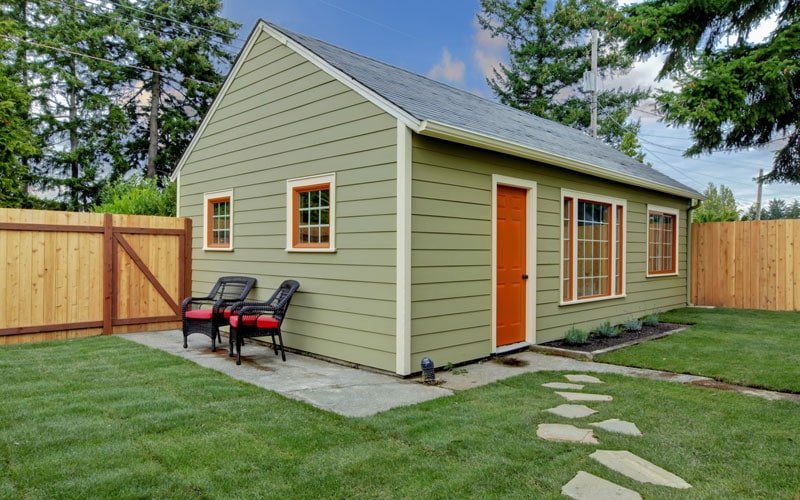Due to the cultural shift to a preference for multigeneration homes instead of single-family houses, the popularity of ADUs has skyrocketed.
So, an ADU is legally part of the same property as the main house, regardless of its physical form. This makes a basement apartment, a backyard cottage, and other namings refer to the same construct.
It cannot be purchased or sold individually, as a condominium or a mobile home may. The owner of the main house is also the owner of the ADU.
If you’re unfamiliar with Accessory Dwelling Units, no worries. You’ve come to the right place. Keep on reading for our full breakdown of what you are and everything else you need to know.
What is an ADU (Accessory Dwelling Unit) in Real Estate
An auxiliary dwelling unit (ADU) is a more modest, self-contained residential dwelling unit. One that is built on the same property as a detached single-family house.
Accessory apartments, supplementary suites, and granny flats are all terms used in the United States to describe ADUs.
Internal ADUs, extensions to new or existing houses (attached ADUs), or new stand-alone auxiliary buildings. Converted sections of existing stand-alone accessory structures are all examples of ADUs (i.e., detached ADUs).
Internal, attached and detached ADUs all have the potential to increase housing affordability. This applies to both homeowners and tenants.
They can also provide a wider range of housing options within the community. It allows seniors to age in places near their families. And make better use of existing housing fabric in established neighborhoods.
As a result, several towns and counties have included ADUs in their plans. As well as enacted zoning laws that allow them in low-density residential zones.
Origins of ADUs
Ancillary residences are a classic concept. Check out DC’s ancient alley flats or the carriage houses found in excellent old Seattle mansions.
They fell out of favor in the middle of the twentieth century. They’re back now, and they’ve got a long list of names.
ADUs (Accessory Housing Apartments) are what planners call them, but they’re also known as granny flats. As well as in-law units, laneway homes, supplementary dwelling units, and a slew of other terms. Small homes can be ADUs, but tiny houses aren’t necessarily ADUs.
People construct them for a variety of reasons. But, according to one research, the most frequent objectives are to earn money via rent and to house a family member.
For environmental, lifestyle, and economic reasons, housing flexibility makes sense. Many people own homes and have lived in them for decades, yet their requirements vary with time.
However, the way homes are constructed now does not reflect these changes. Particularly the fact that families may spend decades with just one or two people.
Many American homes are excessively large for one- or two-person families. This is unfortunate since the size is arguably the single most important element in a house’s environmental effect.
What Are JADUs?
In the simplest of terms, the Junior Accessory Dwelling Units (JADUs) may be built within the parameters of a planned home.
JADUs provide more housing choices. To save money on construction, they can share the same centralized systems. Also, have a simple kitchen with tiny appliances and share a bathroom with the main house.
JADUs merely reuse existing space inside the home rather than expanding the dwelling’s intended occupancy. So, they put no extra strain on utility services or infrastructure.
Understanding ADU Planning
Sure, many towns are interested in increasing housing options by permitting ADUs in single-family zones. Other homeowners may be worried that ADUs would change the character of their neighborhoods. Or cause existing infrastructure to become overburdened.
So far, there is little evidence to substantiate concerns of decreased property prices or parking problems.
On the other hand, there is some evidence that ADUs improve the availability of affordable housing. And, contribute significantly to their host towns’ economies. This leads to building activity and property taxes.
Before developing ADU zoning rules, a housing needs assessment. It might reveal demographic and geographic mismatches between existing housing supply and demand.
As a result, it may be able to predict the total number of ADUs that will be generated in a particular time frame under a permitted regulatory system.
Meanwhile, a residential design study may assist in anticipating the difficulties of integrating ADUs into the already existing single-family neighborhoods.
Take a look at when cities tackle ADUs in their detailed planning. They often include policy suggestions for revising zoning laws. Or, giving the public information about current regulations.
Some municipalities additionally specify which land-use categories. As well as site types that are suitable for ADUs.
You’ll want to check out what the market has to offer at https://actonadu.com/.
What Are the Required Zoning and Permits?
Local legislators permit ADUs right in one or more single-family zoning districts in many cities and counties. This is subject to use-specific requirements.
A need for owner-occupation, dimensions, and design criteria to guarantee neighborhood appropriateness. And off-street parking restrictions are all common stipulations.
Minimum lot sizes and restrictions on the number of inhabitants or bedrooms are also very typical requirements.
Some regulations contain occupancy limits that limit ADUs to accommodate family members or domestic workers exclusively. Yet, this kind of restriction may significantly limit ADUs’ ability to solve a rental housing crisis.
Local governments in certain jurisdictions, like California and Vermont, are required by law to allow ADUs under specific circumstances.
In others, state laws preempt certain elements of local zoning for ADUs. Or, actively urge cities and counties to adopt ADU-friendly zoning rules.
Many older neighborhoods already have a supply of illegally built ADUs. The state gives owners of illegal ADUs some kind of limited amnesty in several of these areas.
These amnesty programs may eliminate permit and inspection costs. This is in return for owners licensing their units. And they usually last for a year or two after they are implemented.
Investing in an ADU: Simplified
If you’re new to investing in the real estate market, you might see ADUs have this confusing mess with conflicting regulations.
But we hope that our guide has shed some light on what makes ADUs tick. And, if you liked our article, then you’ll love checking out our additional tips and strategies. All of those will be available in our real estate section.








